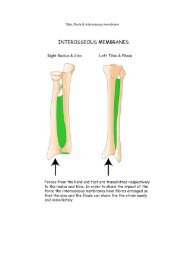GSM 11.11 version 6.2.0 - TTFN Smart card pages
GSM 11.11 version 6.2.0 - TTFN Smart card pages
GSM 11.11 version 6.2.0 - TTFN Smart card pages
- No tags were found...
You also want an ePaper? Increase the reach of your titles
YUMPU automatically turns print PDFs into web optimized ePapers that Google loves.
(<strong>GSM</strong> <strong>11.11</strong> <strong>version</strong> <strong>6.2.0</strong> Release 1997)98TS 100 977 V<strong>6.2.0</strong> (1999-05)BDN disabling. The BDN disabling procedure requires that CHV2 verification procedure has been performedsuccessfully. If not, BDN disabling procedure will not be executed successfully. To disable BDN capability, the MEinvalidates EF BDN . The invalidate/rehabilitate flag of EF BDN , which is implicitly cleared by the INVALIDATEcommand, is at the same time the indicator for the state of the service n°31 (see BDN capability request).BDN enabling. The BDN enabling procedure requires that CHV2 verification procedure has been performedsuccessfully. If not, BDN enabling procedure will not be executed successfully. To enable BDN capability, the MErehabilitates EF BDN . The invalidate/rehabilitate flag of EF BDN , which is implicitly set by the REHABILITATEcommand, is at the same time the indicator for the state of the service n°31 (see BDN capability request).Invalidated BDNs (when BDN capability is disabled) may optionally still be readable and updatable depending on thefile status (see clause 9.3).11.5.2 Short messagesRequirement:Request:Service n°4 "allocated and activated".The SIM seeks for the identified short message. If this message is found, the ME performs thereading procedure with EF SMS .If service n°35 is "allocated and activated" and the status of the SMS is '1D' (status reportrequested, received and stored in EF SMSR ), the ME performs the reading procedure with thecorresponding record in EF SMSR . If the ME does not find a corresponding record in EF SMSR , thenthe ME shall update the status of the SMS with '19' (status report requested, received but not storedin EF SMSR ).If the short message is not found within the SIM memory, the SIM indicates that to the ME.Update:The ME looks for the next available area to store the short message. If such an area is available, itperforms the updating procedure with EF SMS .If there is no available empty space in the SIM to store the received short message, a specific MMIwill have to take place in order not to loose the message.Erasure:The ME will select in the SIM the message area to be erased. Depending on the MMI, the messagemay be read before the area is marked as "free". After performing the updating procedure withEF SMS , the memory allocated to this short message in the SIM is made available for a newincoming message. The memory of the SIM may still contain the old message until a new messageis stored in this area.If service n°35 is "allocated and activated" and the status of the SMS is '1D' (status reportrequested, received and stored in EF SMSR ), the ME performs the erasure procedure for EF SMSR withthe corresponding record in EF SMSR .11.5.3 Advice of Charge (AoC)Requirement:Service n°5 "allocated and activated".Accumulated Call Meter.Request:The ME performs the reading procedure with EF ACM . The SIM returns the last updated value ofthe ACM.Initialization: The ME performs the updating procedure with EF ACM using the new initial value.Increasing: The ME performs the increasing procedure with EF ACM sending the value which has to be added.Accumulated Call Meter Maximum Value.Request: The ME performs the reading procedure with EF ACMmax .Initialization: The ME performs the updating procedure with EF ACMmax using the new initial maximum value.Price per Unit and Currency Table (PUCT).Request: The ME performs the reading procedure with EF PUCT .Update: The ME performs the updating procedure with EF PUCT .ETSI








